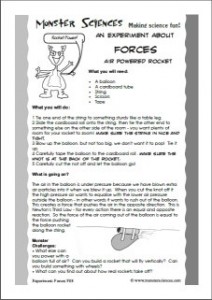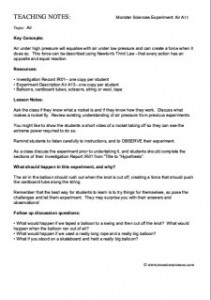Is there a better way to learn about the power of air pressure than building your very own air powered rocket? I don’t think so!
 |
 |
An Air Science Experiment about an air powered rocket
What you will need:
• A balloon
• A cardboard tube
• String
• Scissors
• Tape
What you will do:
- Tie one end of the string to something sturdy like a table leg.
- Slide the cardboard roll onto the string, then tie the other end to something else on the other side of the room – you want plenty of room for your rocket to zoom! Make sure the string in nice and tight.
- Blow up the balloon, but not too big, we don’t want it to pop! Tie it up.
- Carefully tape the balloon to the cardboard roll . Make sure the knot is at the back of the rocket. 5 Carefully cut the not off and let the balloon go!
What is going on?
The air in the balloon is under pressure because we have blown extra air particles into it when we blew it up. When you cut the knot off it the high pressure air wants to equalise with the lower air pressure outside the balloon – in other words it wants to rush out of the balloon. This creates a force that pushes the air in the opposite direction. This is Newton’s Third Law – for every action there is an equal and opposite reaction. So the force of the air coming out of the balloon is equal to the force pushing the balloon rocket along the string.
Monster Challenges:
• What else can you power with a balloon full of air? Can you build a rocket that will fly vertically? Can you build something with wheels?
• What can you find out about how real rockets take off?
TEACHING NOTES: Monster Sciences Experiment: Air A13
Topic:
Air
Key Concepts:
Air under high pressure will equalise with air under low pressure and can create a force when it does so. This force can be described using Newton’s Third Law – that every action has an opposite and equal reaction.
Resources:
• Investigation Record IR01– one copy per student
• Experiment Description Air A13– one copy per student
• Balloons, cardboard tubes, scissors, string or wool, tape
Lesson Notes:
Ask the class if they know what a rocket is and if they know how they work. Discuss what makes a rocket fly. Review existing understanding of air pressure from previous experiments. You might like to show the students a short video of a rocket taking off so they can see the extreme power required to do so. Remind students to listen carefully to instructions, and to OBSERVE their experiment.
As a class discuss the experiment prior to undertaking it, and students should complete the sections of their Investigation Report IR01 from ”Title to “Hypothesis”.
What should happen in this experiment, and why?
The air in the balloon should rush out when the knot is cut off, creating a force that should push the cardboard tube along the string. Remember that the best way for students to learn is to try things for themselves, so pose the challenges and let them experiment. They may surprise you with their answers and observations!
Follow up discussion questions:
• What would happen if we taped a balloon to a swing and then cut off the knot? What would happen when the balloon ran out of air?
• What would happen if we used a really long rope and a really big balloon? • What if you stood on a skateboard and held a really big balloon?
© www.monstersciences.com


